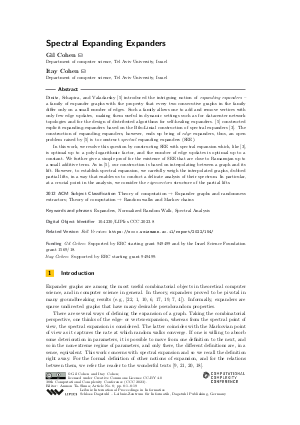Spectral Expanding Expanders
Authors Gil Cohen, Itay Cohen
-
Part of:
Volume:
38th Computational Complexity Conference (CCC 2023)
Part of: Series: Leibniz International Proceedings in Informatics (LIPIcs)
Part of: Conference: Computational Complexity Conference (CCC) - License:
 Creative Commons Attribution 4.0 International license
Creative Commons Attribution 4.0 International license
- Publication Date: 2023-07-10
File

PDF
LIPIcs.CCC.2023.8.pdf
- Filesize: 0.73 MB
- 19 pages
Document Identifiers
Related Versions
- Full Version https://eccc.weizmann.ac.il/report/2022/154/
Subject Classification
ACM Subject Classification
- Theory of computation → Expander graphs and randomness extractors
- Theory of computation → Random walks and Markov chains
Keywords
- Expanders
- Normalized Random Walk
- Spectral Analysis
Metrics
- Access Statistics
-
Total Accesses (updated on a weekly basis)
0Document
0Metadata
Abstract
Dinitz, Schapira, and Valadarsky [Dinitz et al., 2017] introduced the intriguing notion of expanding expanders - a family of expander graphs with the property that every two consecutive graphs in the family differ only on a small number of edges. Such a family allows one to add and remove vertices with only few edge updates, making them useful in dynamic settings such as for datacenter network topologies and for the design of distributed algorithms for self-healing expanders. [Dinitz et al., 2017] constructed explicit expanding-expanders based on the Bilu-Linial construction of spectral expanders [Bilu and Linial, 2006]. The construction of expanding expanders, however, ends up being of edge expanders, thus, an open problem raised by [Dinitz et al., 2017] is to construct spectral expanding expanders (SEE). In this work, we resolve this question by constructing SEE with spectral expansion which, like [Bilu and Linial, 2006], is optimal up to a poly-logarithmic factor, and the number of edge updates is optimal up to a constant. We further give a simple proof for the existence of SEE that are close to Ramanujan up to a small additive term. As in [Dinitz et al., 2017], our construction is based on interpolating between a graph and its lift. However, to establish spectral expansion, we carefully weigh the interpolated graphs, dubbed partial lifts, in a way that enables us to conduct a delicate analysis of their spectrum. In particular, at a crucial point in the analysis, we consider the eigenvectors structure of the partial lifts.
Cite As Get BibTex
Gil Cohen and Itay Cohen. Spectral Expanding Expanders. In 38th Computational Complexity Conference (CCC 2023). Leibniz International Proceedings in Informatics (LIPIcs), Volume 264, pp. 8:1-8:19, Schloss Dagstuhl – Leibniz-Zentrum für Informatik (2023)
https://doi.org/10.4230/LIPIcs.CCC.2023.8
BibTex
@InProceedings{cohen_et_al:LIPIcs.CCC.2023.8,
author = {Cohen, Gil and Cohen, Itay},
title = {{Spectral Expanding Expanders}},
booktitle = {38th Computational Complexity Conference (CCC 2023)},
pages = {8:1--8:19},
series = {Leibniz International Proceedings in Informatics (LIPIcs)},
ISBN = {978-3-95977-282-2},
ISSN = {1868-8969},
year = {2023},
volume = {264},
editor = {Ta-Shma, Amnon},
publisher = {Schloss Dagstuhl -- Leibniz-Zentrum f{\"u}r Informatik},
address = {Dagstuhl, Germany},
URL = {https://drops.dagstuhl.de/entities/document/10.4230/LIPIcs.CCC.2023.8},
URN = {urn:nbn:de:0030-drops-182780},
doi = {10.4230/LIPIcs.CCC.2023.8},
annote = {Keywords: Expanders, Normalized Random Walk, Spectral Analysis}
}
Author Details
Funding
- Cohen, Gil: Supported by ERC starting grant 949499 and by the Israel Science Foundation grant 1569/18.
- Cohen, Itay: Supported by ERC starting grant 949499.
References
-
Miklós Ajtai, János Komlós, and Endre Szemerédi. Deterministic simulation in logspace. In Proceedings of the nineteenth annual ACM symposium on Theory of computing, pages 132-140, 1987.

- Alon Amit and Nathan Linial. Random graph coverings. I. General theory and graph connectivity. Combinatorica, 22(1):1-18, 2002. URL: https://doi.org/10.1007/s004930200000.
- Yonatan Bilu and Nathan Linial. Lifts, discrepancy and nearly optimal spectral gap. Combinatorica, 26(5):495-519, 2006. URL: https://doi.org/10.1007/s00493-006-0029-7.
- Nikolas P. Breuckmann and Jens N. Eberhardt. Balanced product quantum codes. IEEE Trans. Inform. Theory, 67(10):6653-6674, 2021. URL: https://doi.org/10.1109/tit.2021.3097347.
- Michael Dinitz, Michael Schapira, and Asaf Valadarsky. Explicit expanding expanders. Algorithmica, 78(4):1225-1245, 2017. URL: https://doi.org/10.1007/s00453-016-0269-x.
- Irit Dinur. The PCP theorem by gap amplification. J. ACM, 54(3):Art. 12, 44, 2007. URL: https://doi.org/10.1145/1236457.1236459.
-
Irit Dinur, Shai Evra, Ron Livne, Alexander Lubotzky, and Shahar Mozes. Locally testable codes with constant rate, distance, and locality. In Proceedings of the 54th Annual ACM SIGACT Symposium on Theory of Computing, pages 357-374, 2022.

-
Chris Godsil and Gordon F Royle. Algebraic graph theory, volume 207. Springer Science & Business Media, 2001.

-
Shlomo Hoory, Nathan Linial, and Avi Wigderson. Expander graphs and their applications. Bulletin of the American Mathematical Society, 43(4):439-561, 2006.

-
Russell Impagliazzo, Noam Nisan, and Avi Wigderson. Pseudorandomness for network algorithms. In Proceedings of the twenty-sixth annual ACM symposium on Theory of computing, pages 356-364, 1994.

-
Alexander Lubotzky, Ralph Phillips, and Peter Sarnak. Ramanujan graphs. Combinatorica, 8(3):261-277, 1988.

-
Adam Marcus, Daniel A Spielman, and Nikhil Srivastava. Interlacing families I: Bipartite Ramanujan graphs of all degrees. In 2013 IEEE 54th Annual Symposium on Foundations of computer science, pages 529-537. IEEE, 2013.

-
Adam W Marcus, Daniel A Spielman, and Nikhil Srivastava. Interlacing families IV: Bipartite Ramanujan graphs of all sizes. SIAM Journal on Computing, 47(6):2488-2509, 2018.

- Adam W. Marcus, Daniel A. Spielman, and Nikhil Srivastava. Finite free convolutions of polynomials. Probab. Theory Related Fields, 182(3-4):807-848, 2022. URL: https://doi.org/10.1007/s00440-021-01105-w.
- A. Nilli. On the second eigenvalue of a graph. Discrete Math., 91(2):207-210, 1991. URL: https://doi.org/10.1016/0012-365X(91)90112-F.
- Gopal Pandurangan, Peter Robinson, and Amitabh Trehan. DEX: self-healing expanders. Distrib. Comput., 29(3):163-185, 2016. URL: https://doi.org/10.1007/s00446-015-0258-3.
- Omer Reingold. Undirected connectivity in log-space. J. ACM, 55(4):Art. 17, 24, 2008. URL: https://doi.org/10.1145/1391289.1391291.
- Daniel A Spielman. Spectral and algebraic graph theory, 2019. URL: http://cs-www.cs.yale.edu/homes/spielman/sagt/.
-
Amnon Ta-Shma. Explicit, almost optimal, epsilon-balanced codes. In Proceedings of the 49th Annual ACM SIGACT Symposium on Theory of Computing, pages 238-251, 2017.

- Luca Trevisan. Lecture notes on graph partitioning, expanders and spectral methods, 2017. University of California, Berkeley, URL: https://people.eecs.berkeley.edu/luca/books/expanders-2016.pdf.
-
Salil P Vadhan. Pseudorandomness. Foundations and Trendsregistered in Theoretical Computer Science, 7(1-3):1-336, 2012.

- Leslie G. Valiant. Graph-theoretic properties in computational complexity. J. Comput. System Sci., 13(3):278-285, 1976. URL: https://doi.org/10.1016/S0022-0000(76)80041-4.
